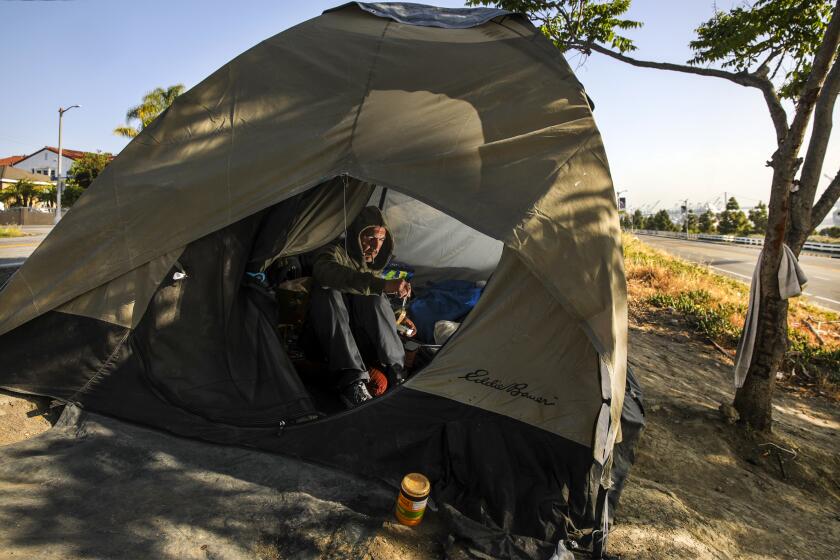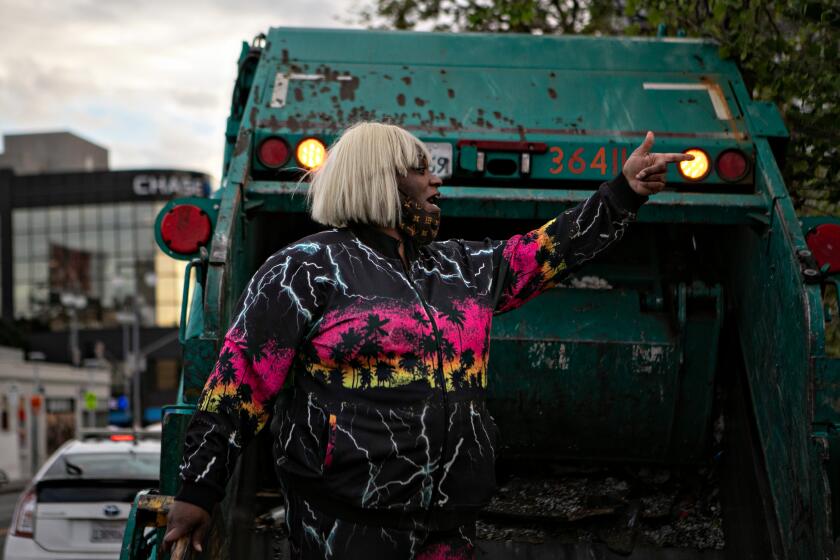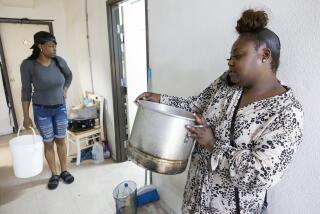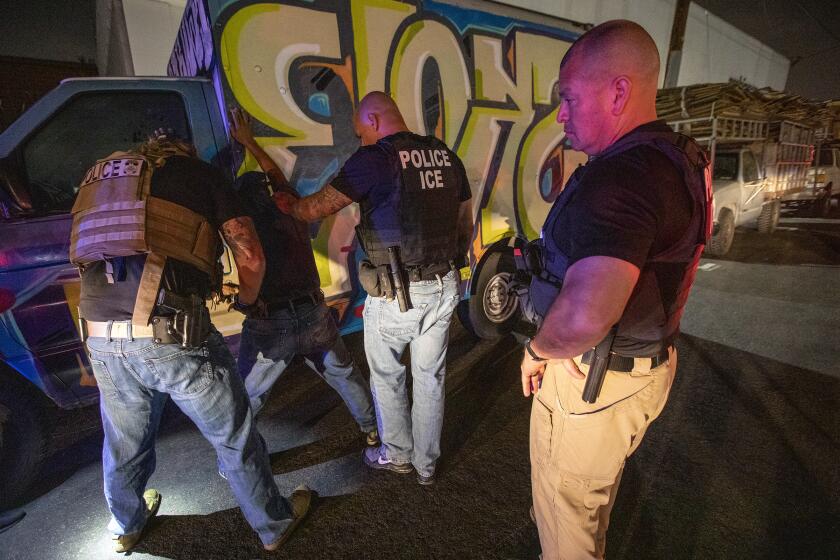L.A. skid row residents angry over the destruction of a community hub
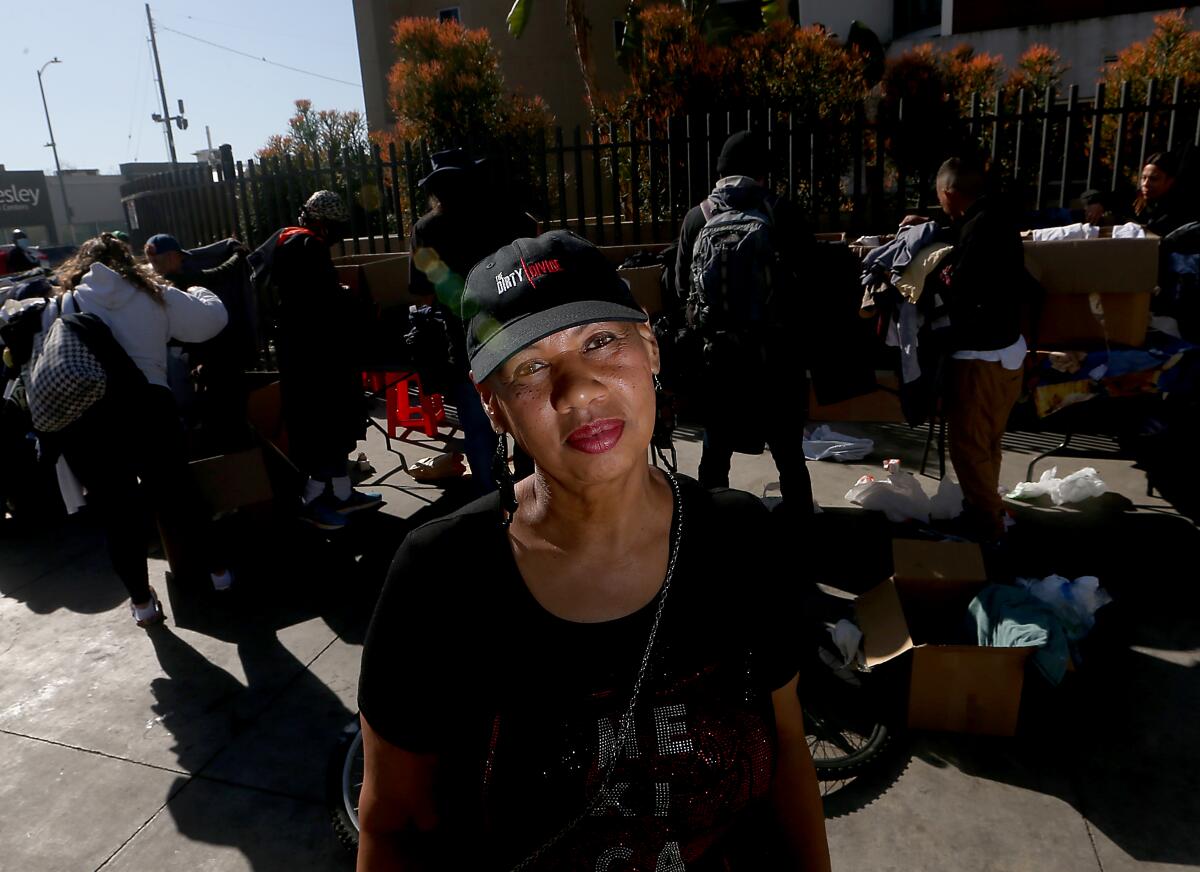
- Share via
The “white house” stood on a street corner in the heart of skid row, white canopy tents hitched together on a wheeled platform that served as the home of an activist and an ad hoc community center for the unhoused.
It was a place where people could drop off donations, distribute food and host events. Women could go there to pick up hygiene and menstrual products.
The canopy tent house was a palace by skid row standards. It had windows and linoleum floors. There was a sewing area, two queen-size beds, two dressers, portable toilets, an inflatable hot tub, a microwave and a toaster, and was powered by solar panels and a generator.
“It was a safe haven,” said Stephanie Williams, the owner. “Skid row is a dangerous place, so I wanted to have a safe place for people to come and eat and rest.”
But last week, sanitation crews showed up to dismantle the pop-up home at 5th and San Pedro streets, sparking community outrage and speculation as to why it was demolished.
“It was callous, it was mean and, in many ways, it was calculative,” said Pete White, a witness and executive director of L.A. Community Action Network. “You had no less than 12 to 15 cops, you had heavy equipment, and the [sanitation crews] came out to essentially demolish that corner while letting the tents across the street remain.”
Elena Stern, spokesperson for the city’s Department of Public Works, said the Feb. 13 operation was part of a biweekly scheduled cleanup. Street signs in the area warn about the cleanups, which require homeless people to temporarily move their property from the sidewalk. Unless contaminated, items left on the sidewalk are taken to a storage facility where people can retrieve them.
On a strip of dirt called the Gulch, along Gulch Road in San Pedro, homeless people face a city deadline and an uncertain future.
Stern said the canopies and other items removed from the site were placed at the facility.
But news footage and videos on social media showed a crane from a dump truck damaging the canopies as it scooped them off the sidewalk, and crews discarding tables used for the distribution of food and clothes.
Williams said sanitation crews gave her 30 minutes to move her belongings, but she became too distraught to grab much when they told her the house was going to be demolished.
“I said wait a minute, it’s on wheels. I can push it around the corner. We can push it to the street. We can do a lot of things other than demolishing it,” she recalled.
But the crews didn’t budge.
“They were destroying personal property like it was the thing to do when they know they have to store that property,” White said. “Even if they claim it’s oversize, they don’t have the right to destroy it.”
Previous lawsuits have barred the city from discarding the personal items of unhoused people.
Stern did not respond to additional questions about the cleanup.
Williams has lived on skid row since 2013, when she arrived at the Greyhound bus station from Indianapolis. She said she had a broken right leg from excessive police force.
Until that moment she didn’t know much about skid row, but people there offered her a wheelchair and helped her get around. Williams, a fashion designer, said she volunteered to alter clothes for people in the area.
Eventually she made her way to 5th and San Pedro streets, where she said she witnessed the 2015 fatal police shooting of 43-year-old Charly “Africa” Leundeu Keunang, a homeless man.
The killing motivated her to become more active in the community. She considered herself a Los Angeles Police Department watchdog, holding officers accountable if she thought they were violating people’s rights.
In the spring of 2019, Williams had an idea for a resource center. She was already receiving donations from church groups and nonprofit organizations and distributing them to residents.
Demetrius Stigar, founder of Hungry Mouths, a nonprofit that serves the needy, donated two canopies to Williams shortly after meeting her that year.
“She was telling me all her plans and how she wanted to turn it into a resource center, and, you know, that’s what she ended up doing,” he said. “I’ve seen so many people receive help in that corner alone.”
Williams documented the development of the white house on her Facebook account, posting dozens of videos, including tours of the site and interactions with people who had stopped to check out the interior.
“This is like an apartment,” one man says in a video.
In another, two women notice her two sewing machines.
“I teach with one and use the other for myself,” Williams tells the women. “They were donated. I asked and prayed for one and I got two.”
“You got everything.”
“I got everything; people can come and cook. I have a microwave, I have a little oven, I have emergency food, I got water and a toaster. I got hardwood floors; y’all didn’t see that part.”
There are also dozens of videos capturing life at the house. They show faith-based groups and nonprofit organizations distributing meals, a barber cutting people’s hair and people making protest signs. There are videos of religious sermons, dancing events and band performances.
“This was a community space for cultural expression,” White said. “It was one of the best things in the community, one of the models on how to provide services.”
Williams said every August she would bring out an inflatable pool for the children, and every Friday was open mic night. “It was a fun place,” she said.
The destruction of such a space led residents to speculate why the home and community center was destroyed. Some suspected it was part of L.A. Mayor Karen Bass’ emergency homeless ordinance, while others thought it was officials retaliating against Williams for her activism.
The heavy machinery and police presence were an unusual sight.
Williams said typically she would only see cleaning crews show up with a power-washing machine. She said crews would also help her move her house and belongings. But this time, crews refused to speak to her.
“It was ugly the way they did it, though,” she said. “It was an ugly way to get rid of somebody.”
Protesters target city and county employees, even getting into a shoving altercation with a staff member of City Councilman Kevin de León.
The Rev. Andy Bales, chief executive director of Union Rescue Mission, said he was driving to work that Monday morning when he saw the crews clearing the street corner.
“I saw the machinery, lots of police officers, a lot of people yelling, and what looked like pieces of [her] tent being lifted up,” he said, adding that the operation seemed like more than just a cleanup.
Bales said he initially thought the activity was part of Bass’ Inside Safe initiative, which aims to clear encampments by offering people hotel and motel rooms.
“I haven’t seen that kind of destruction,” he said. “It was pretty bold to lift someone’s foundation that has been sitting there for years.”
Williams said she felt she was being targeted in part because of her activism in the area and because she had a tiny home on wheels that the city didn’t want.
White said the presence of police officers made the cleanup effort bothersome. He said officers were trying to provoke an already angry crowd. He said one officer reached for his service weapon and another pointed a stun gun at him.
“At one point we had one cop, a white cop, stand on the stage, which was destroyed later, and did a jig,” he said. “This white cop in a Black community during Black History Month, robbing this Black woman of all her stuff and all things she gives to the community, stands there and dances.”
An LAPD spokeswoman did not respond to requests for comment.
On Wednesday afternoon, Leilani Togislala, 41, a skid row resident, stood at the street corner, surprised to see the white house was gone.
“It’s not good, it’s not good,” she said. “I’ve gotten clothes, food and blankets at the house.”
Across the street, outside a women’s center, Tracey Huffaker, 50, said she had gone to the house for socks and underwear. She said at least one woman has stayed at the house when she didn’t have shelter. Williams said she took in a mother and her three children until they were able to get a hotel room. It has been three years, she said, and the family hasn’t received permanent housing.
On Sunday morning, Williams was back at the street corner. A dozen large boxes stuffed with clothes and shoes sat on top of four folding tables. She planned to be there all day to help distribute food.
Williams said she has received temporary shelter and is awaiting permanent housing. Even after she gets a home, she plans to return to skid row to help people.
“I’m going to do another white house,” she said, smiling. “I’m not going to stop because they’re not housing the people.”
More to Read
Sign up for Essential California
The most important California stories and recommendations in your inbox every morning.
You may occasionally receive promotional content from the Los Angeles Times.
